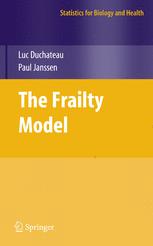

Most ebook files are in PDF format, so you can easily read them using various software such as Foxit Reader or directly on the Google Chrome browser.
Some ebook files are released by publishers in other formats such as .awz, .mobi, .epub, .fb2, etc. You may need to install specific software to read these formats on mobile/PC, such as Calibre.
Please read the tutorial at this link: https://ebookbell.com/faq
We offer FREE conversion to the popular formats you request; however, this may take some time. Therefore, right after payment, please email us, and we will try to provide the service as quickly as possible.
For some exceptional file formats or broken links (if any), please refrain from opening any disputes. Instead, email us first, and we will try to assist within a maximum of 6 hours.
EbookBell Team

4.0
86 reviewsClustered survival data are encountered in many scientific disciplines including human and veterinary medicine, biology, epidemiology, public health and demography. Frailty models provide a powerful tool to analyse clustered survival data. In contrast to the large number of research publications on frailty models, relatively few statistical software packages contain frailty models.
It is demanding for statistical practitioners and graduate students to grasp a good knowledge on frailty models from the existing literature. This book provides an in-depth discussion and explanation of the basics of frailty model methodology for such readers. The discussion includes parametric and semiparametric frailty models and accelerated failure time models. Common techniques to fit frailty models include the EM-algorithm, penalised likelihood techniques, Laplacian integration and Bayesian techniques. More advanced frailty models for hierarchical data are also included.
Real-life examples are used to demonstrate how particular frailty models can be fitted and how the results should be interpreted. The programs to fit all the worked-out examples in the book are available from the Springer website with most of the programs developed in the freeware packages R and Winbugs. The book starts with a brief overview of some basic concepts in classical survival analysis, collecting what is needed for the reading on the more complex frailty models.
Luc Duchateau is Associate Professor of Statistics at the Faculty of Veterinary Medicine of the Ghent University, Belgium. He is board member of the Quetelet Society (Belgian Region of the International Biometric Society) and of the International Biometric Society Channel Network. He has collaborated extensively with physicians in oncology and allergy, public health workers and veterinarians, and is an author of numerous papers in statistical, medical and veterinarian journals.
Paul Janssen is Professor of Statistics at the Centre for Statistics of the Hasselt University, Diepenbeek, Belgium. He is an elected member of the International Statistical Institute. He spent research visits at the Johns Hopkins University (Baltimore, USA) and the University of Washington (Seattle, USA). His research interests include survival analysis, nonparametric estimation, resampling techniques and asymptotic theory.